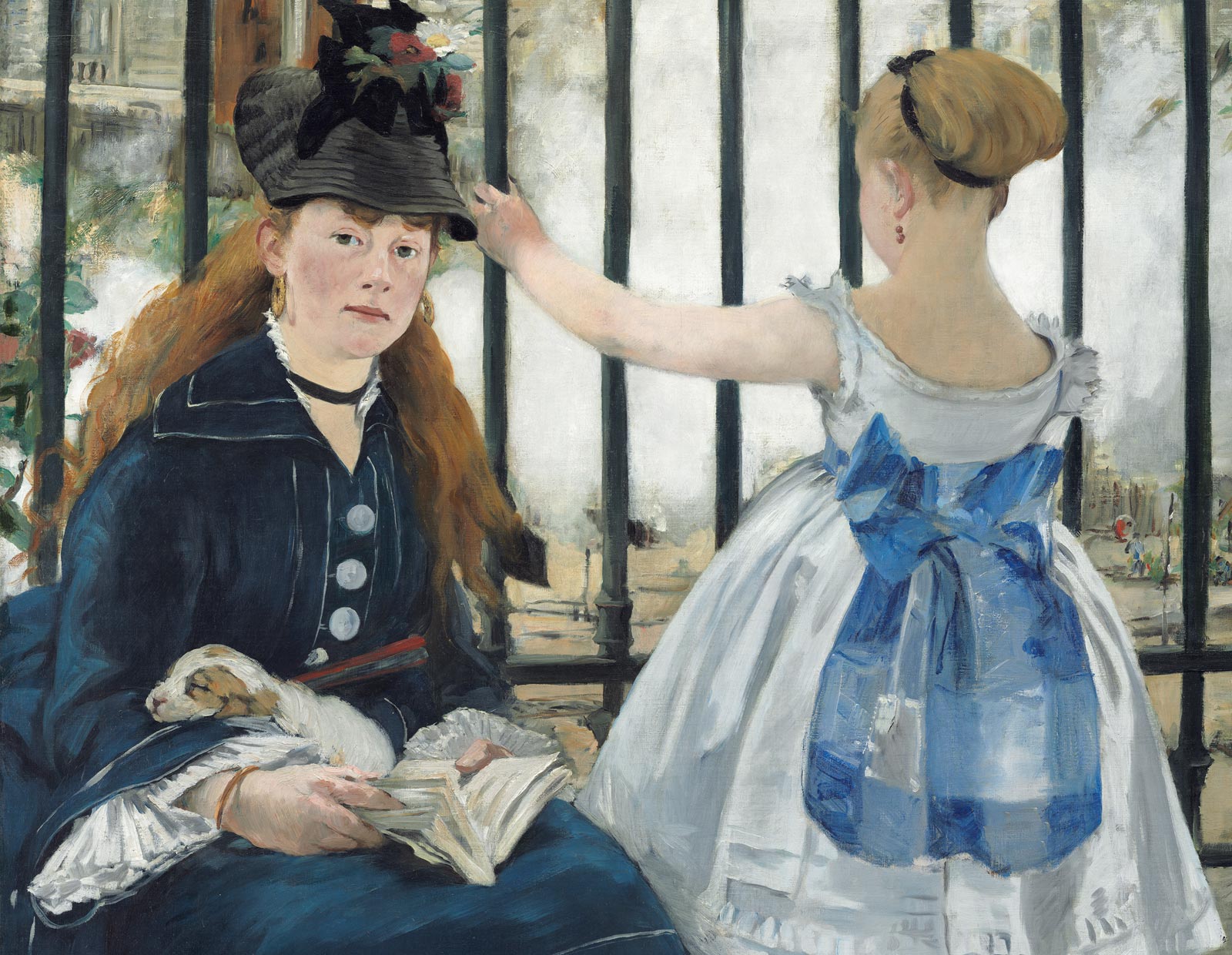Born in Paris to a wealthy family, Édouard Manet showed promise in drawing and caricature from an early age. After twice being denied admission to France’s prestigious Naval College, he enrolled in 1850 at the studio of academic artist Thomas Couture. While copying paintings at the Louvre, Manet became attracted to the bold brushwork of Spanish painter Diego Velázquez. He soon adopted a free manner of painting that opposed the polished surfaces revered by academic artists. Rather than gradually building up a composition with layers of blended pigments and translucent glazes, Manet selected and applied patches of color side by side, from the start, for their final effect.
With her back to us, a young girl stands looking through a fence. Facing us directly, a woman sits with a small dog in her lap and a book in her hand. Billowing steam from an unseen train obscures the center background, but the edge of a bridge juts out at right, identifying the setting as Gare Saint-Lazare—Paris’ busiest train station and emblem of the city’s unsettling 19th-century makeover.
Beyond depicting the modern city,
Most critics fumed at what they called Manet’s trivial and inscrutable subject matter (as well as his strident colors, loose brush work, and trademark flatly painted forms). Few recognized that with its discomfiting mix of immediacy, psychological detachment, and indefinite narrative, The Railway represented the way Paris’ urban renewal program, of which railroads were a centerpiece, had destabilized social relations in the city.
About the Artist

Henri Fantin-Latour, Édouard Manet, 1867. Art Institute of Chicago.

Edouard Manet, The Old Musician, 1862, oil on canvas, Chester Dale Collection, 1963.10.162
Manet set out on his own artistic career in 1856. Soon after, his focus on modern subject matter—street scenes, bar life, and backhanded versions of famous art icons—coupled with his unconventional paint handling, regularly provoked critics’ wrath. Olympia, a painting of a naked courtesan who frankly engages the viewer in parody of the classic Venus, triggered an unparalleled scandal when it was exhibited at the 1865 Salon. The uproar made Manet the de facto leader of the avant-garde.
Manet’s bold style, contemporary subject matter, and determination to challenge entrenched academic models influenced younger artists who would come to be known as the impressionists. Manet, too, learned from them, lightening his palette and using even freer brushwork. But he did not share the impressionists’ spontaneity; the striking immediacy of Manet’s greatest works resulted from a deliberate process involving drawing, models, and painting in a studio. Still determined to make his mark in the official Salon, he declined the more radical option of exhibiting with the impressionists.
Manet continued producing enigmatic and inventive paintings about urban life until his death in 1883. While he had gained a reputation as an influential innovator, only posthumously would he be recognized as a father of modern art.
Related Works in the Collection

Edouard Manet, The Railway Restaurant, c. 1879, pen and brown ink on wove paper laid down, Collection of Mr. and Mrs. Paul Mellon, 2006.128.25

Edouard Manet, Masked Ball at the Opera, 1873, oil on canvas, Gift of Mrs. Horace Havemeyer in memory of her mother-in-law, Louisine W. Havemeyer, 1982.75.1

Jean Béraud, Paris, rue du Havre, c. 1882, oil on canvas, Ailsa Mellon Bruce Collection, 1970.17.2
Explore all Collection Highlights

